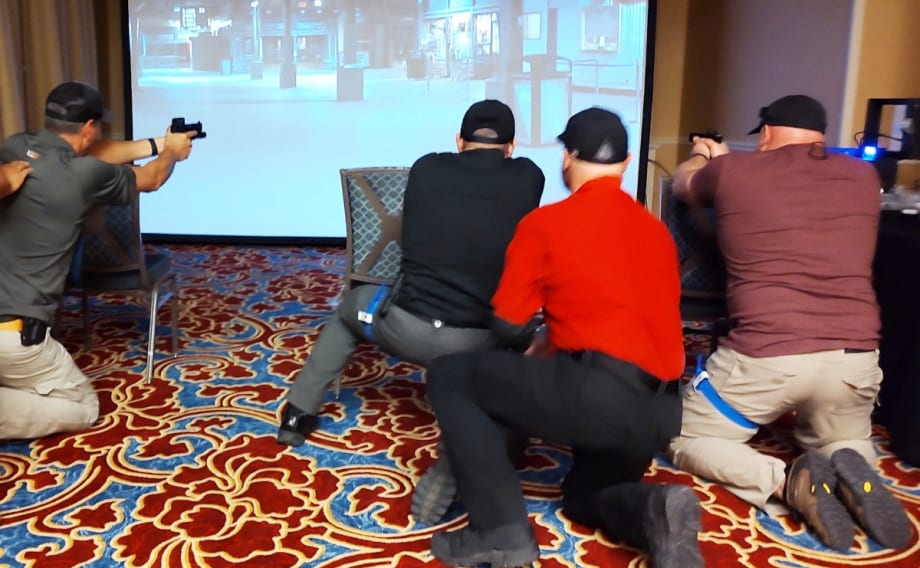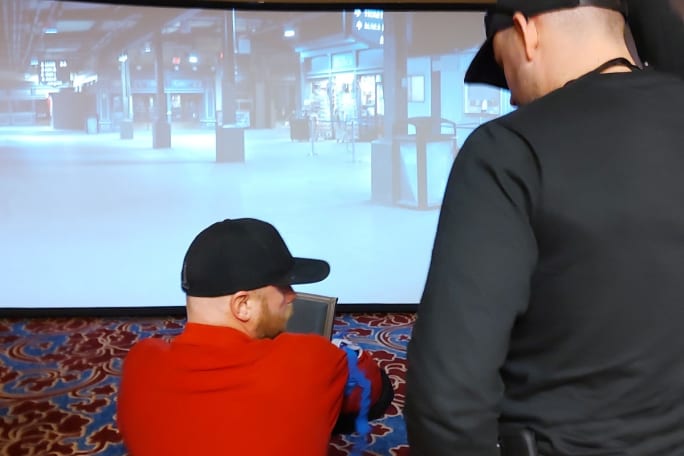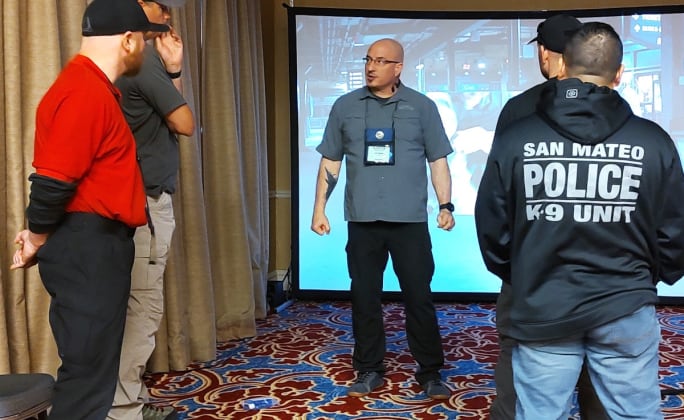For officers, the ability to apply a tourniquet under threat not only can save their lives but it can also keep them in the fight. It is up to law enforcement trainers to help them prepare for just such a situation, according to Lon Bartel, director of training and curriculum for VirTra .
Tourniquet Application Under Threat
Officers can’t always rely on help when wounded, so they should be able to apply a tourniquet to stop their bleeding, even while still taking fire. Ron Bartel shares some tips on how trainers can coach cops on such scenarios during training.

Trainers participate in a scenario that requires them first to apply a tourniquet, then stay in the fight and engage a threat during a VirTra simulation led by Lon Bartel.
Wayne Parham
During the 2024 International Law Enforcement Educators and Trainers Association annual conference , Bartel used a VirTra simulator to teach class participants how to challenge their officers during tourniquet training scenarios. During his Tourniquet Application Under Threat session, he ran three stations and rotated officers through several evolutions, each bringing a new layer of challenge.
In the first evolution, three volunteers raced to see who could properly apply a tourniquet the fastest. There was no simulated threat at this point in the class, yet stress was created. That rivalry among peers while being watched by a roomful of fellow officers, according to Bartel, induced a little bit of stress.
Starting with that small stress, trainers can ramp up the intensity, just as Bartel did in the following evolutions.
“When bad juju happens, what happens to the body's stress? I'm going to argue that stress is a context of the environment you perform in. It's part of it,” explained Bartel. “So, if you are not creating some level of elevation of arousal state, are you really training them to fight to compete to do what they need to do in that environment?”
So, trainers must find some way to modulate the arousal state, the stress level, of the people they are training. A trainer need not yell in someone’s ear to induce stress; there are other ways, as Bartel had just demonstrated.
As the class moved into the second-round scenario, Bartel provided the class participants with a Glock and a simulated threat via the VirTra screen and system. For the sake of the training, each of the three officers who stepped to the front of the line were provided a chair in front of them to use as simulated cover . The seats of the chairs faced the officers, providing a shelf for their firearms while they applied a tourniquet.
Related: 5 Things to Know Before Buying VR Training Systems
“The premise that we're going to use is at some point in time you caught a round, you already had your gun out, maybe that's the window that I'm going to create in this, we're going to have some level of what I call a fiction contract,” Bartel explained to the trainers. “And what I mean by that is we accept when we create a training environment there is some level of fiction that we have to accept, some level of make-believe.”
Each took a kneeling position behind a chair. From Bartel’s “Go” signal each officer was allowed 45 seconds to apply a tourniquet . In the first group of three, the primary arm was hit. There were things to decide, the trainees had to solve problems quickly.

A trainer who serves as a coach confirms the tourniquet has been applied properly by a fellow officer during a training scenario at ILEETA.
Wayne Parham
“I've created an environment where you can't put the gun in a holster, for whatever reason, maybe it's ripped off, maybe you don't have it. I've created a shelf (the seat of the chair) in front of you. I've created a situation where you can tuck it under your knee, I've created a situation where you can put it on the ground. But if you have to put it on the ground, you have to think about all of the advantages and disadvantages,” Bartel said. “I am talking about creating problems for you to solve.”
As the officers applied the tourniquet, a threat emerged and fired. Again, Bartel was creating stress.
The supporting coaches, standing directly behind the ones active in the scenario, were also tasked with being the backup officers arriving and checking their fellow officers for additional wounds.
As the next three stepped forward, Bartel handed a little more power off to the coaches to induce stress by choosing which limb would be wounded on their corresponding trainee in front of them. The stress now came from the officer not knowing which limb would need a tourniquet and then responding quickly. Some of the coaches chose the support arm, others chose a leg.
While teaching the trainers how to coach, Bartel took a momentary break to talk about being coaches and not instructors.
“I’m not a big fan of the term instructor. I like coach. Instructors get you to a minimum standard, your state qualifications. That preps people for a gunfight ? No,” said Bartel. “What's a coach do? A coach gets the best out of you that day, regardless of what your baseline is for that day, because every day varies. There's a major difference between those two mindsets.”

Lon Bartel instructs fellow trainers before the start of a scenario.
Wayne Parham
Bartel continued through evolutions, adding more challenges — turning the seat of the chairs (simulated cover) away from the officers to remove the shelf they could place their guns on while applying tourniquets and adding multiple layers of threats and more gunfire.
“I create problems for people to solve,” Bartel added.
Trainers or coaches must set the speed of the training. While going slow may be okay foundationally in the beginning, according to Bartel, the pace must be ramped up.
“In the beginning of this conversation, we talked about, if you want to run faster, run fast. If you want to swim faster, you swim, you don't run, there's a specificity to it,” explained Bartel. “Where I run into challenges is people think that if I go slow, I'm going to get really good at it, you actually lay the motor program down at the speed at which you practice it.”
It is up to that trainer to create the scenario, set the pace, create the stressors, then coach the officer or trainee through it.
Feedback is critical.
It is more than, “Good job.”
“We want to give good solid feedback,” he explains. “At this moment in time, you got hung up, why? What happened?”
Through that feedback, the coach can walk the trainee through his or her decision-making. A good coach will ask questions as part of the feedback. Ideally, that stimulates the thought process and increases the learning as the trainee explores how they handled their decision-making under stress.
Read More: Traits of a Great Firearms Instructor
More Patrol

10 Tips for Felony/High-Risk Stops
What steps can officers take to stay safer during felony or high-risk vehicle stops? Here are 10 tips from Mike Willis, Law Enforcement National Training and Program Director for the US Deputy Sheriff's Association.
Read More →
Amped Highlights Power Behind Amped FIVE Software
Amped FIVE empowers you to advance your investigations with confidence and precision, from the crime scene all the way to the courtroom.
Read More →
Police K-9 Killed, Suspect Dies in Shootout with Cops
A Burbank Police Department K-9 was fatally shot over the weekend by a passenger who fled on foot from a traffic stop. The armed suspect was killed in a shootout with officers.
Read More →
From the Show Floor: InVeris
In this video, learn about how InVeris provides training to law enforcement, including customized augmented reality scenarios. The augmented reality system can scan up to 10,000 square feet of real-life environments and create a curriculum based on those spaces.
Read More →
From the Show Floor: Polaris Government & Defense
Learn about Polaris Government & Defense in this video as POLICE visits their show booth to discover their side-by-sides and the advantages they provide for agencies.
Read More →
Dashcam Video Shows Officers Rescue Man from Burning Car
Dashcam video released by a New Jersey police department shows two of its officers rescuing an unconscious man from a burning car after a crash.
Read More →
Aimpoint COA optic + A-CUT Named Red Dot of the Year
The Aimpoint COA optic + A-CUT system has been named Red Dot of the Year by Guns & Ammo magazine. The new optic system was introduced in January 2025.
Read More →
From the Show Floor: Axon
Join POLICE as we visit with Abi Stock, of Axon, to learn about the company’s latest technology offerings, such as Axon Assistant, Form One, and the DFR integration with Skydio.
Read More →
Back Face Deformation, Brain Injury and Ballistic Helmets – Why the “Dent Doesn’t Matter” Claim Ignores Science
Alex Poythress, co-founder and CEO of Ballistic Armor Co., explains why ballistic helmet buyers should insist on full test data, including BFD measurements, standoff distance, and padding configuration, rather than rely solely on penetration ratings.
Read More →
Streamlight Marks 15 Years of Support for Breast Cancer Research Foundation With $20k Donation
In its 15th year of supporting the Breast Cancer Research Foundation, Streamlight donated $20,000 to help in the fight against cancer. Donations were generated through the sale of special Wedge XT models and other pink flashlights.
Read More →

